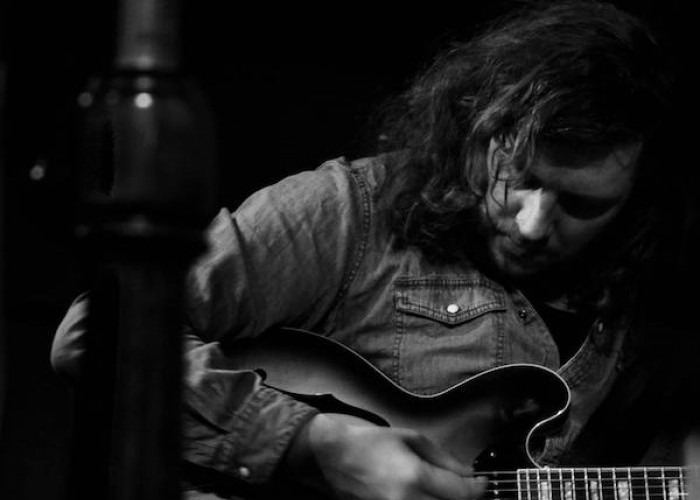Dec 9, 2025 12:28 PM
In Memoriam: Gordon Goodwin, 1954–2025
Gordon Goodwin, an award-winning saxophonist, pianist, bandleader, composer and arranger, died Dec. 8 in Los Angeles.…

Guitarist Raphael Roginski has performed as a solo artist, in duos and in numerous ensembles.
(Photo: Wieslaw Szuminski, from Raphael Roginski’s Facebook page)Polish guitarist Raphael Roginski discusses creativity with the same type of idiosyncratic, poetic aesthetic informs his stunning music.
“I recognized that playing an instrument should be like playing on veins or your hair,” he said. “It must be part of your body. Most of my guitar sounds are like an instrument made from ribs and veins.”
Through the use of different tuning systems and a largely self-taught practice that privileges scrabbling tangles of notes over familiar melodic flow, Roginski indisputably makes his guitar sound like something other than a conventional instrument.
When he was a young boy, his grandmother gave him a traditional spike fiddle, known as a kemenche.
“It was to make my dreams come true,” he said, referring to his grandmother’s gift and his childhood desire to own a guitar. “This gesture is still the basis for my music, how to create culture.”
Before eventually picking up an actual guitar, Roginski approached the kemenche like it was a guitar, eschewing the traditional bow and developing a singular style wherein melodies where shaped in gnarled clusters.
He first started reaching fans outside of Poland through his work in jazz-related ensembles, such as Hera, a wide-ranging internationally flavored ensemble led by clarinetist Waclaw Zimpel, and Shofar, a wildly careening trio with fire-breathing saxophonist Mikolaj Trzaska that brought a free-jazz intensity to traditional Jewish music, particularly nigunim.
But his music reaches much further, whether he’s playing art-rock in Wovoka, instrumental surf music in Alte Zachen or moody, richly atmospheric post-klezmer with the wonderful Cunfukt. In each context his playing stands out, just as it did in more jazz-related settings. In Hera he injected a brooding intensity that articulated melodies in a bizarrely non-linear fashion that made each solo an adventure.
In recent years, however, Roginski has distinguished himself through a series of recordings that mix solo performances and duets with a handful of distinctive female singers. Since 2015 he’s made three albums for the Bolt label’s Populista series, reinventing music by John Coltrane, baroque composer Henry Purcell, and obscure folk songs of Kurpie people from the Mazovia region of Poland. There are moments where a listener can’t miss a familiar Purcell air or a melodic phrase from “Countdown,” but by and large Roginski has made the music all his own.
He feels that the connective tissue for all of his work is the blues. “Around the world, the blues helped people cross traumas, problems,” he said. “So this also proves that you don’t need to be in the Mississippi Delta to be in the blues stream.”
He explained that his love for jazz came from listening to jazz icon Jim Hall, which reminded him of the sound of guitar-playing in Russian cinema.
Although Roginski blanches at categorizing the music he makes himself, he also views the work of some of his musical heroes as antithetical to genre. “I don’t know if my ‘jazz’ masters like Phil Cohran, Albert Ayler and Henry Threadgill are still in jazz,” he said. “I think it’s a different tradition—that’s more like new folk.
“I was born as a refugee in Germany,” Roginski continued. “My father was Jewish and my mother a mix of Tatar and Uzbeki, so part of my childhood was a very weird reality, like Chinatown mixed with Fiddler on the Roof,” he said with a laugh.
Roginski is a searcher who has traveled widely, absorbing sights and sounds and reaching for new connections. His language may be improvisation, but he refuses to be bound by a single dialect. “I would improvise with a Macedonian drummer more than jazz improv musicians,” he said. “We artists have a mission to be people free from cultural borders. You should breathe all of the air in the world. It’s not hard.”
(For information on the album Raphael Roginski Plays John Coltrane And Langston Hughes, African Mystic Music, visit the Bolt website. The Wexler Oral History Project at the Yiddish Book Center has posted a YouTube video of Roginski improvising on acoustic guitar. To see it, click here.) DB

Goodwin was one of the most acclaimed, successful and influential jazz musicians of his generation.
Dec 9, 2025 12:28 PM
Gordon Goodwin, an award-winning saxophonist, pianist, bandleader, composer and arranger, died Dec. 8 in Los Angeles.…

Belá Fleck during an interview with Fredrika Whitfield on CNN.
Jan 13, 2026 2:09 PM
The fallout from the renaming of the John F. Kennedy Center for the Performing Arts to include President Donald…

Flea has returned to his first instrument — the trumpet — and assembled a dream band of jazz musicians to record a new album.
Dec 2, 2025 2:01 AM
After a nearly five-decade career as one of his generation’s defining rock bassists, Flea has returned to his first…

“It’s a pleasure and an honor to interpret the music of Oscar Peterson in his native city,” said Jim Doxas in regard to celebrating the Canadian legend. “He traveled the world, but never forgot Montreal.”
Nov 18, 2025 12:16 PM
In the pantheon of jazz luminaries, few shine as brightly, or swing as hard, as Oscar Peterson. A century ago, a…

Dec 11, 2025 11:00 AM
DownBeat presents a complete list of the 4-, 4½- and 5-star albums from 2025 in one convenient package. It’s a great…